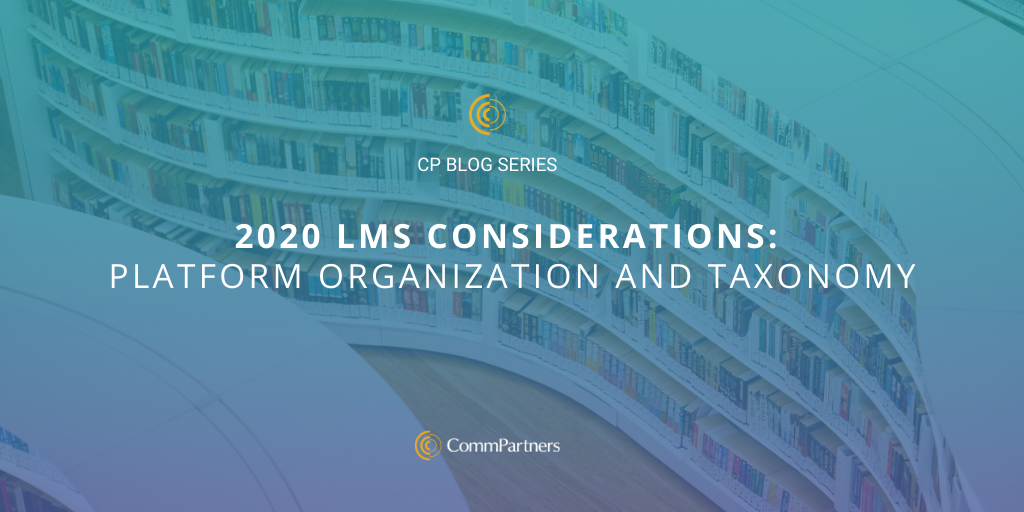
by Julie Ratcliffe | Sep 10, 2020 | Blog, Education
Imagine going to Amazon to purchase a new book and there is no search feature. You have to scroll through every single item Amazon sells until you come across the book you wanted. Phew, nightmare over. Not only does Amazon have a search bar, but it anticipates what you’re looking for, recommends what you might want next based on previous purchases, and items are organized into categories so you can easily search for what you’re looking for on your own.
Continuing our more in-depth look into CommPartners, CEO, Rich Feinstein’s The Evolution of the Association LMS: 10 Considerations for 2020, let’s talk about organizing content. Whether you’ve just implemented your LMS and you’re starting fresh with your organization system, or you’ve had it for years and you’re learning catalog could use a critical eye, a good taxonomy strategy is essential.
For many associations, their LMS is the primary source for education and connection since the pandemic started and their digital assets are growing. Creating a simple way to search and find content is essential for learners. There are several taxonomy and organization strategies to optimize searching and presentation of content:
“The more robust your taxonomy is, the better you’re empowering the LMS to meet your goals and changing goals,” Arianne Urena, Elevate Implementation and Project Manager. Arianne recommends establishing a taxonomy strategy as your first step when implementing your LMS. Consider these questions when developing your strategy:
- What content is offered on your site? Make a list of everything.
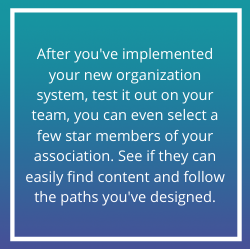
- What is the priority of each offering? Start with the essential items for your learners and then add in the supplemental pieces.
- Which assets are revenue generators? Mark those.
- Who is your audience? Are they familiar with an LMS? New members? Old members? How are they accessing the LMS? Member role? Job type? Apply the necessary categories.
- Use case: How will they navigate? How long does it take for them to find an asset? How do you correct any navigation delays?
- What is the ideal layout for your content on your LMS? What is the first thing a learner sees on the site? Second, third, fourth?
Once you’ve organized your content and you’ve established a robust taxonomy strategy, you can apply other organizational methods:
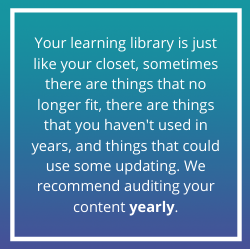
- One-click imagery or terms: Make finding content a snap by organizing it into categories and requiring only “one-click” to navigate.
- Keyword search: Include a keyword search bar on your LMS site so learners can search through your well organized content library.
- Personalized learning paths: To help your learners get started on their learning journey and navigate through all the content options, provide them with personalized learning pathways based on career paths, member roles, etc. with the individualized attention of an “advisor” from your staff. To learn how to create these paths, join us for our upcoming webinar Creating Personalized Learning Journeys.
- Self-Assessment Quiz: This is your chance to become the advisor. CommPartners’ Elevate has a new feature that allows administrators to gauge competency and make personalized content recommendations to learners based on their quiz results. Click here to find out more about the self-assessment quiz feature.
Creating a simple and easy-to-follow path to content within your LMS will eliminate frustration while encouraging your learners to register and keep coming back for more. To learn more about organization options for your LMS or Elevate, contact Meghan Gowen at mgowen@commpartners.com.

by Julie Ratcliffe | Aug 28, 2020 | Blog
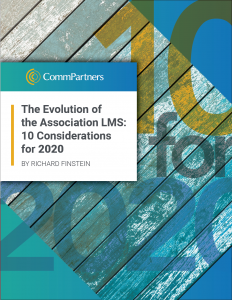 We are now more than half-way through 2020, and this has been a year of adaptation and finding new ways to engage learners. At the start of this year, our CEO, Rich Finstein, published The Evolution of the Association LMS: 10 Considerations for 2020, a resource outlining how associations can ensure they are getting the most out of their LMS by increasing impact and reach in 2020. And now, in a time where membership is meeting and learning online more than ever, these ideas seem to speak louder.
We are now more than half-way through 2020, and this has been a year of adaptation and finding new ways to engage learners. At the start of this year, our CEO, Rich Finstein, published The Evolution of the Association LMS: 10 Considerations for 2020, a resource outlining how associations can ensure they are getting the most out of their LMS by increasing impact and reach in 2020. And now, in a time where membership is meeting and learning online more than ever, these ideas seem to speak louder.
We feel these topics can be explored further and are ideas that do not expire in 2020. In this series, we’re taking a deeper look into some of the tactics presented in this resource. Check back monthly for the remainder of the year to see which topic we’ll be covering next! First up, Community and Learning.
Take a look at Rich’s 10 Considerations for 2020 here if you haven’t already!
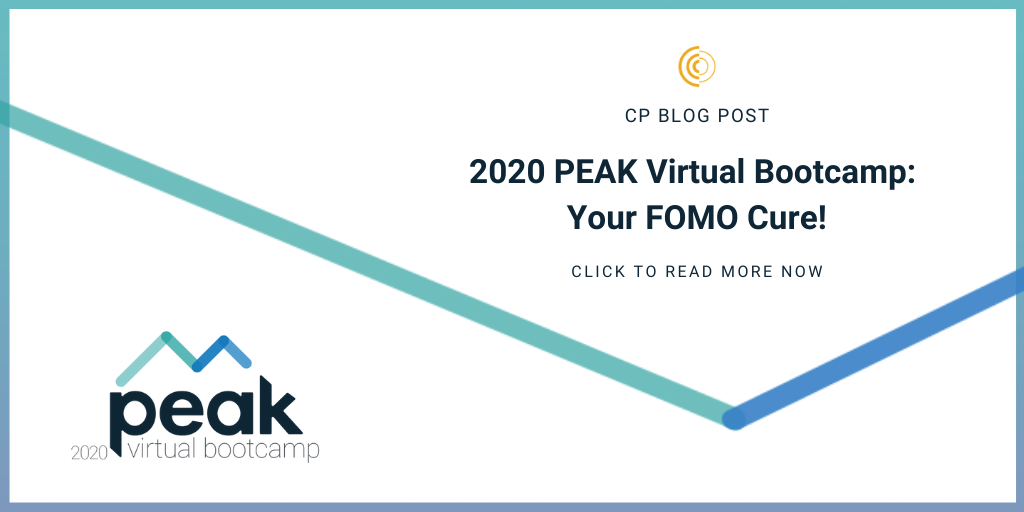
by Julie Ratcliffe | Aug 7, 2020 | Blog
This year, PEAK took the shape of a Virtual Bootcamp, an afternoon of rewarding sessions featuring the expertise of the CommPartners team and covering a topic that is top of mind: Virtual Conferencing.
While we specialize in eLearning and managed online events, we do enjoy meeting our community face-to-face at our User Group Conference, so we were disappointed we couldn’t be at Nationals Stadium this year to do just that. However, we were excited to adapt to a virtual event so we could demonstrate what’s possible.
If you’re experiencing some FOMO (fear of missing out) right now, fear not – we have a cure! Here is a run-down of some key takeaways from each session!
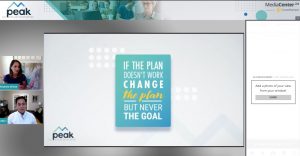 Session 1: Adapting with CommPartners + Virtual Conferencing Basics
Session 1: Adapting with CommPartners + Virtual Conferencing Basics
-
-
- Secure “Buy-In”: Before going virtual, show members of your organization what others in your industry are doing. “The trend is your friend,” as Maricela Arias-Cantu, Director of Professional Development, SOPHE said in the Client Panel.
- Avengers Assemble! Create an event team with clearly defined roles.
Session 2: Session 2: Sponsorship, Exhibit Halls, Discussion Boards, Oh My!
-
-
- What’s on the Menu? Create an exhibitor prospectus to ensure sponsor visibility.
- Get Creative! Connect with speakers, sponsors, and attendees through discussion boards, photo or social media walls, Virtual Happy Hours, games, musical or comedy acts, entertainers, or celebrity appearances – the possibilities are endless!
Session 3: How to Make Your Virtual Conference Website “Pop!”
-
-
- It’s All About UX: The goal of the conference website is to encourage engagement before, during, and after the event.
- Redundancy in Navigation: Make sure your attendees know where to find essential information like sessions, FAQs, exhibit halls, resources, etc.
Session 4: Client Success Panel and Q&A

-
-
- Be Flexible When Pivoting to a Virtual Event: GFOA narrowed their sessions down from 80 to 47 and spread them out over four weeks.
- Find Harmony: Establish a balanced relationship between your event team and the Conference Producer.
- Know Your Industry! AAWA was the first organization to go virtual in their industry and offered a discount to anyone who previously registered for a canceled conference.
- Explore the Benefits of Pairing Your Virtual Conference with an LMS: Bundle your on-demand content or make launching your conference site a breeze with an LMS!
Thank you to everyone who attended PEAK 2020 Virtual Bootcamp, we hope you feel empowered and prepared to take on your next virtual event with confidence.
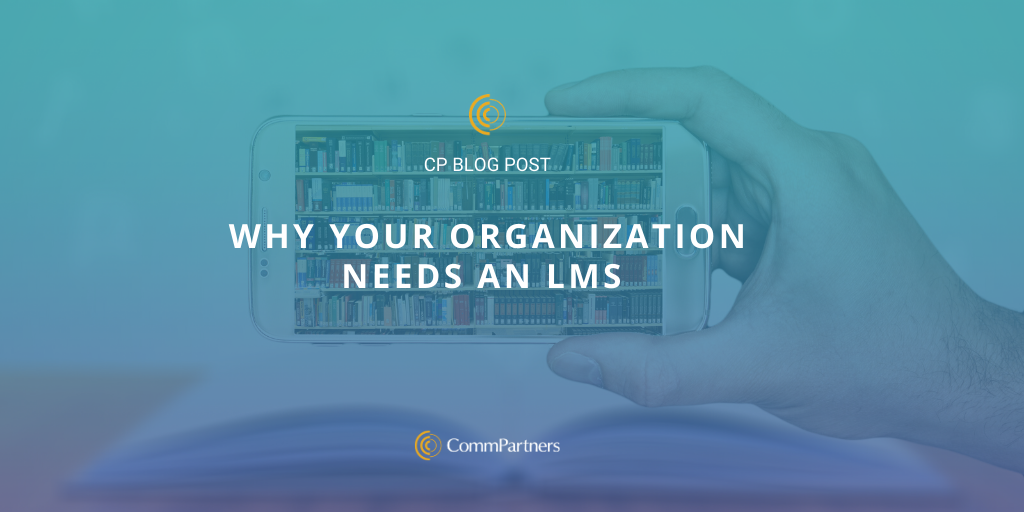
by Julie Ratcliffe | Jul 14, 2020 | Blog
A Learning Management System, or LMS, is software designed for online training, tracking, and reporting that supports content creation and storage for continued learning. An LMS provides your organization or association an opportunity to create a learning community on an eLearning platform. Sound like something that would benefit your membership?
Knowing some advantages of an LMS can help your Development Team determine if an LMS is a right fit for your organization:
-
-
- Create Customized Learning Paths: Create a customized learning journey for each of your members using curated content stored in your LMS. Each pathway can be adjusted as a member’s role within the organization grows and changes.
- Avoid Skill Gaps: Skill gaps are the abilities a new hire might not bring to the table, but the position requires or would benefit from it. Offer training and courses to membership that creates a well-rounded professional and encourages continued learning.
- Doubles as an Event Platform: An LMS can serve as an event platform. Host relevant webinars or a Town Hall once a month. Take it a step further and host your next conference virtually through your LMS.
- Develop an On-Demand Learning Catalog: As your learning community grows, your resources will grow. All the content from previous events can be repurposed and reused. Upload podcasts, relevant media links, anything you think your learners will benefit from. Soon you will have a robust catalog of knowledge within your LMS to draw and learn from at any time.
- Measure Performance: Track and report the performance of members to watch growth, target weak points, and acknowledge achievements.
- Onboard Members: Create learning paths for membership onboarding, so each new member is familiar with organization culture and procedures.
- Certification Opportunities: Allow members to keep up with professional certifications easily.
- Reach Membership Virtually: For organizations with wide-spread membership, an LMS provides a way to reach each learner. An LMS prepares your organization for online learning.
When considering an LMS for your organization, do your research. Understand you are creating a knowledge community for your organization while reaching membership in a new way. To find out more about CommPartners’ LMS, Elevate, click here or contact Meghan Gowen, VP of Client Development at mgowen@commpartners.com.
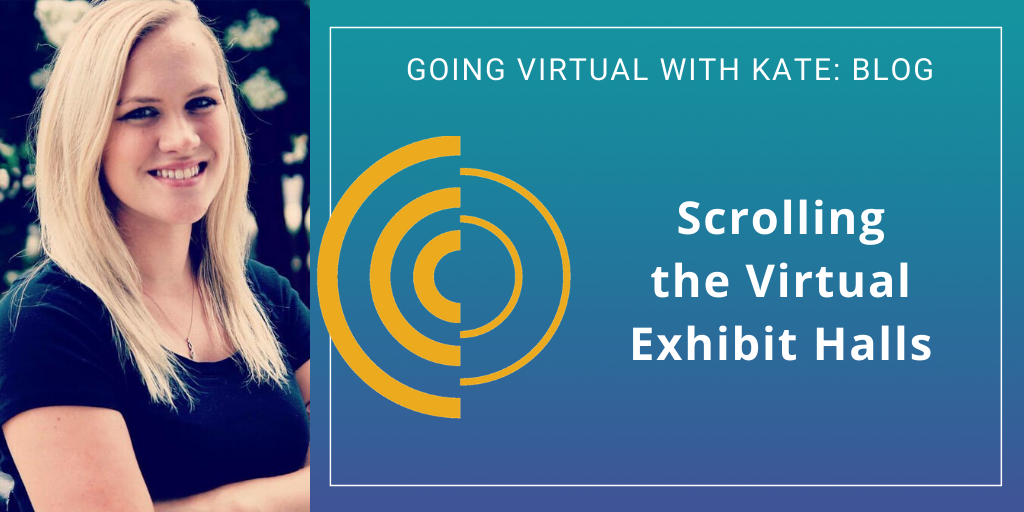
by Julie Ratcliffe | May 21, 2020 | Blog, FaceBook Live
As you transition your on-site event to a Virtual Conference, it is important to consider how you will include the sponsors and other revenue opportunities your organization was counting on while providing a resource center for attendees. In a previous post, we touched on how to monetize your Virtual Conference, including integrating a Virtual Exhibit Hall into your Virtual Conference. Exhibit Halls can be converted to an online format easily and can be just as informative for attendees.
Designing Your Exhibit Hall
A Virtual Exhibit Hall is a home base for all your sponsors. The exhibit hall and each booth can be personalized, depending on the needs of your organization and sponsors/exhibitors. Before designing your Exhibit Hall, identify what features and customization you will be offering to sponsors/exhibitors in their booths.
PDFs, links, or any other resources that would typically be provided to attendees can be housed here. Video and photo assets like commercials or instructional videos or even photo albums can have a dedicated section apart from the downloadable assets and links, all within the individual booths. Going virtual doesn’t mean you lose all the exhibit’s visual and branding opportunities; sponsor logos can be presented in a carousel or posted in various positions around the conference site. Informational and educational posters can be displayed in each sponsor booth, or you can show them all in a collection on a separate posters page
Additional booth features include options for exhibitors and attendees to interact. In each exhibitor booth, there can be a dedicated section for exhibitor staff to “man” the booths and network with attendees via a chat feature. A successful virtual booth should be customized to match the sponsor/exhibitor branding. Have them submit logos or supporting images for greater brand presence.
When it comes to transitioning an Exhibit Hall from in-person to virtual, it just requires some creativity. Use this guide to see how easy it is to transform your on-site Exhibit Hall to a Virtual Exhibit Hall.
Make it Interactive
Once you’ve designed the perfect virtual hall to display your sponsors/exhibitors, the next step is to make sure your attendees interact with the page and the exhibitors. Sponsors are an important part of the vitality of your conference and learners should engage with them. Unlike at an on-site event, where exhibitors are confined to Exhibit Hall hours, your Virtual Exhibit Hall will be open 24/7. Use these tips to encourage activity on your Virtual Exhibit Hall:
- Chat Feature: Whether it’s instant messaging or a discussion board, provide ways for attendees to interact with sponsors.
- Scavenger Hunt: Organize a scavenger hunt around the entire Virtual Conference website leading attendees to the Virtual Exhibit Hall. You can make higher-level sponsors a required stop on the scavenger hunt!
- Credits or Certifications: Offer your attendees a certificate or credit opportunities if they network or interact with sponsors or exhibitors.
- Giveaways/Specials: Encourage your sponsors to offer specials or product giveaways when attendees visit their booth.
- Surveys: Include a survey on your expo page.
- Forms: Embed a Contact Me form to grow your subscriber list.
Including a Virtual Exhibit Hall can be a creative solution to include sponsors, provide more educational resources, and deliver a community-building opportunity. Create a stronger learning community with an interactive Exhibit Hall.
Click here to learn more
To learn more about Virtual Exhibit Halls, contact marketing@commpartners.com





 We are now more than half-way through 2020, and this has been a year of adaptation and finding new ways to engage learners. At the start of this year, our CEO, Rich Finstein, published
We are now more than half-way through 2020, and this has been a year of adaptation and finding new ways to engage learners. At the start of this year, our CEO, Rich Finstein, published 
 Session 1: Adapting with CommPartners + Virtual Conferencing Basics
Session 1: Adapting with CommPartners + Virtual Conferencing Basics


